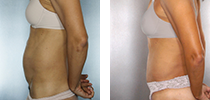Nasal Fractures
Conveniently located to serve the areas of New York, NY

Addressing nasal fractures is one of the most effective ways to reshape the nose after trauma or damage changes its shape or structure. During injuries, the delicate bones and cartilage in the nose shift easily, often resulting in aesthetic changes and functional issues that may affect airflow. Surgical procedures for nasal fractures can address cosmetic and functional issues to improve one’s confidence and quality of life.
Dr. John E. Sherman has helped many patients achieve life-changing results. As a plastic surgeon with over 40 years of experience dedicated to helping patients achieve superb results. He has performed thousands of facial fracture operations, and is a member of the prestigious American Society of Maxillofacial Surgeons. He is well known for his ability to help patients balance their features with customizable procedures based on their unique anatomy.
Contact our office or call (212) 535-2300 to schedule an appointment at our New York location and learn more.
Contents
- 1 About Nasal Fractures
- 2 Timing of Treatment
- 3 Subsequent Treatment (Septoplasty)
- 4 Benefits
- 5 Candidates
- 6 Consultation
- 7 Preparation
- 8 Procedure
- 9 Recovery
- 10 Results
- 11 The Cost of Treating Nasal Fractures in NYC
- 12 FAQ
- 12.1 Can addressing nasal fractures also help with breathing issues?
- 12.2 How do I know which type of procedure for nasal fractures is the right fit for me?
- 12.3 How long does a nasal fracture procedure take?
- 12.4 Can I combine nasal fracture procedures with other treatments?
- 12.5 Will addressing nasal fractures result in visible scars?
- 13 References
About Nasal Fractures
The ultimate goal of any nasal reconstruction surgery is to restore or refine the appearance and function of the nose. The most commonly injured bone of the facial skeleton is the nasal bone. (1) This occurs as a result of physical trauma, accidents, previous surgeries, congenital conditions, and sports injuries. Initially, the patient may notice only swelling, blood from the nose (epistaxis), and pain. With swelling present, the actual fracture may easily be overlooked by the emergency room physician. What initially may appear to be subtle, after swelling subsides may be more profound.
Plain X-rays are not always useful in diagnosing nasal fractures, and patients often need a CT scan to rule out more serious injuries. (2) Dr. Sherman will confirm that you have completed the proper imaging tests so that he can create an effective treatment plan.
Timing of Treatment
After the patient is involved in an accident with the possibility of nasal fracture, the time they receive treatment is essential. If the nasal bones are not fixed immediately, it is best to wait at least 4 days for swelling to resolve. After that time, the nasal bones may be reduced to their original position (closed reduction of nasal fracture) under local anesthesia or sedation anesthesia. The procedure takes less than one hour, without any incisions being made. If however, the patient delays after 2 weeks, the simple closed reduction cannot be performed because the nasal bones are not as mobile. Dr. Sherman instructs the patient to wait at least 4 to 6 weeks so that an open reduction of the nasal fracture can be performed.
Subsequent Treatment (Septoplasty)
After sustaining nasal trauma, the cartilage of the nasal septum can warp, causing a deviated septum. A deviated septum can cause nasal obstruction. Correction of the septum can be done at any time and be performed in the office or in the hospital. Because this is a functional problem, and not aesthetic, the operation may often be reimbursed through insurance.
Benefits
There are several benefits of addressing nasal fractures, including:
- Improved aesthetics: We can help you improve the appearance of your nose to restore facial harmony.
- Boosted self-esteem: We can help you improve your self-confidence with a personalized procedure for your unique anatomy.
- Lasting results: The procedure permanently adjusts the position of the nasal bones and cartilage.
- Improved functionality: Reshaping the nose after nasal fractures can improve airflow, making breathing easier.
Candidates
Suitable candidates for nasal fracture treatments are in good overall health and want to improve their appearance or address functional problems affecting their breathing or sleep. If you smoke, you will need to stop temporarily for approximately 6 weeks before and after the procedure. Suitable candidates do not have any medical conditions that would prevent them from receiving anesthesia. You will, however, need to have realistic expectations about what you can achieve based on your underlying anatomy.
Consultation
During your consultation, Dr. Sherman will ask about your medical history and aesthetic goals to determine the best treatment plan for your needs. You must discuss your aesthetic goals openly with Dr. Sherman because even the slightest changes to the dimensions of your nose can significantly affect your appearance. Nasal reconstruction involves aesthetic details and alterations that cannot be hidden under apparel, making it one of the most complex procedures due to the nuances involved.
Preparation
To prepare for a nasal fracture procedure, you must stop taking medications and supplements that thin the blood. Dr. Sherman can provide specific preparation instructions based on your treatment plan. You will also need to temporarily stop smoking and arrange for someone to drive you home. We recommend scheduling time off work so you can recover comfortably. Running errands and picking up prescriptions preemptively can minimize stress and allow you to focus on healing.
Since many patients with nasal fractures experience swelling, Dr. Sherman will likely ask you to wait four days after the fracture for the swelling to subside. This will allow him to manipulate the nasal bones more easily. However, you must not wait more than two weeks after the fracture to have the surgery to prevent the bones from settling into their new position.
Procedure
During your procedure, our team will cleanse your skin, and a board-certified anesthesiologist will administer anesthesia. Dr. Sherman usually prefers to manipulate the bones of the nose with a closed reduction of the fracture. This is done after four days when the swelling has subsided. A closed reduction can be performed in the office setting or as an outpatient procedure at the hospital.
Some of the techniques used for nasal reconstruction are:
- Cartilage grafts: Dr. Sherman can use cartilage from elsewhere to modify the nose, if necessary.
- Regional flaps: If your nose is severely damaged, he may excise a portion of skin from another area of the body and use it to modify the nose.
- Local flaps: Dr. Sherman can manipulate the position of nasal tissue by using tissue from the cheeks or forehead.
- Skin grafts: Dr. Sherman can use tissue from one another area of the body to reconstruct the nose.
- Suture closure: Dr. Sherman will carefully close the incisions after making modifications to prevent scarring.
- Secondary intention healing: Depending on your underlying anatomy and the complexity of the procedure, Dr. Sherman may leave the incision open instead of placing sutures to allow your body to form new tissue.
If Dr. Sherman determines that you need another open reduction procedure after 2-3 weeks of downtime, you must wait approximately two months for the nasal bones to settle into their new position. Dr. Sherman will ask you to return to the office to perform the open reduction under sedation anesthesia.
Recovery
Your recovery time will depend on the techniques Dr. Sherman uses and the condition of your nose. For reconstruction surgeries involving more minor modifications, the recovery period ranges from 1-2 weeks. Significant reconstructive surgery often requires over 3-8 weeks for recovery. Dr. Sherman can remove any sutures 5-7 days after the procedure. The scars and incisions may appear red and raised initially but typically fade into your skin over the next few weeks. You should be able to resume your normal activities in 10-14 days as long as you do not participate in contact sports or activities that could put pressure on your nose.
Recovery time will depend on your treatment plan and the type of procedure Dr. Sherman performs. Some extensive procedures are followed by minor touch-ups and revisions several months after the primary surgery to improve aesthetics.
You will need to wear a splint for 6-7 days after the procedure, but you should be able to return to light work after 2 days. Over the next 3-4 weeks, the nasal bones will settle into their new position.
While the bones settle, it is not uncommon to have some changes to your airflow months later because of changes to the septal cartilage (septum). If this occurs, Dr. Sherman can perform a septoplasty procedure to adjust the septum of the nose to improve your airflow. (3)
Results

After a nasal fracture procedure, you can enjoy a more balanced appearance and a smoother nose shape. You can also enjoy relief from functional issues affecting your breathing. Your final results may not be visible right away since it can take some time for the swelling to subside and the bone to set into its new position. Addressing nasal fractures can open the nasal airway and make breathing easier, resulting in an improved quality of life.
The Cost of Treating Nasal Fractures in NYC
The cost of treating nasal fractures will depend on your specific treatment plan. Contact our office to schedule your consultation and learn about the specials we offer at our New York location.
Whether you are a local or an out-of-town patient, we offer several financing options to make your treatment accessible.
FAQ
Can addressing nasal fractures also help with breathing issues?
Yes. Some types of nasal fractures can create functional problems, and we can address them by customizing the procedure to meet your specific needs.
How do I know which type of procedure for nasal fractures is the right fit for me?
We can physically examine your nose to determine the best treatment plan for your needs.
How long does a nasal fracture procedure take?
It can take several hours, depending on the type of modifications you need to make to improve the shape and appearance of your nose after a fracture.
Can I combine nasal fracture procedures with other treatments?
Yes, our procedures are customizable, and we can combine your procedure with other treatments to help you achieve your unique goals.
Will addressing nasal fractures result in visible scars?
We make discreet incisions that are easy to conceal for a natural-looking appearance.
References
- Alvi S, Patel BC. Nasal Fracture Reduction. PubMed. Published 2021. https://www.ncbi.nlm.nih.gov/books/NBK538299/
- Rhee J, Belisle S, Strychowsky J. Nasal fractures. Canadian Medical Association Journal. 2024;196(2):E51-E51. doi:https://doi.org/10.1503/cmaj.231013
- Tao F, Feng Y, Sun B, Wang J, Chen X, Gong J. Septoplasty Effect on the Enhancement of Airflow Distribution and Particle Deposition in Nasal Cavity: A Numerical Study. Healthcare. 2022;10(9):1702. doi:https://doi.org/10.3390/healthcare10091702




